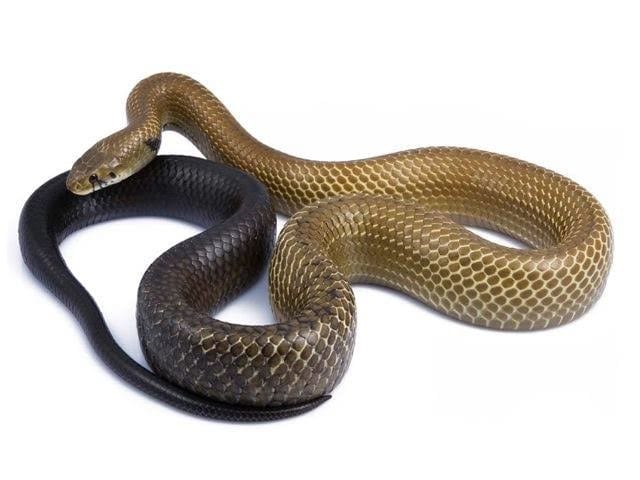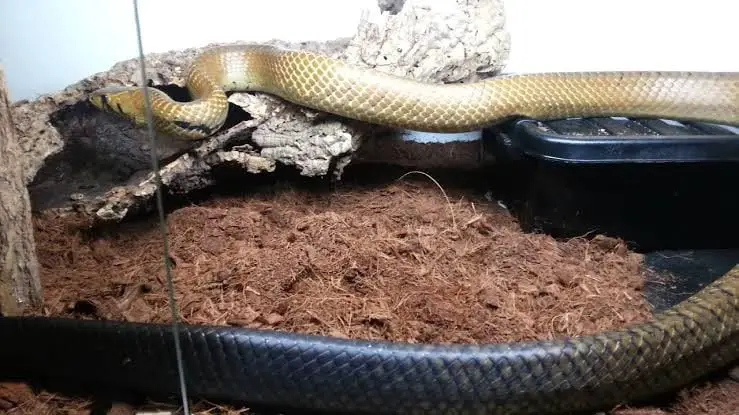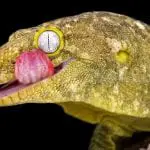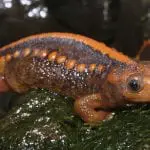Scientific Facts
| Common Name: | Blacktail Cribo |
| Scientific Name: | Dymarchon melanurus |
| Life Span: | More than 20 years in captivity |
| Size: | 6 to 8 feet long |
| Habitat: | Tropical areas, upland forests, dry forests |
| Country of Origin: | Central America (including Texas, Mexico, and Colombia) |
Physical Description

The Blacktail Cribo, which is also popularly known as the Middle American Indigo Snake, is a somewhat large species of snake that is popular for its two-toned appearance and their docile and moderately aggressive nature (in comparison to other types of snakes that are more aggressive). These can be found in tropical areas all over Central America and commonly stay in dry and upland forested areas.
You would know where and how the Blacktail Cribo got its name from just by looking at it. The upper part of its body (from the central part all the way to the head) appears to have an indigo-like color that can sometimes vary. There are those with lighter colors such as yellowish, gray, light brown, golden brown, or even bronze. Hence, that is why it is also called the Middle American Indigo Snake.
However, the light color from the head will slowly and steadily darken as you go down through the body as it eventually quickly becomes a darker color when you reach the part where the tail parts. While the upper part of the tail may look close to dark brown in color, it eventually becomes black by the time you get to the middle portion of the tail. That is why this snake is also called the Blacktail Cribo.
The Blacktail Cribo actually has a very glossy appearance as the scales in all parts of its body take on a shiny kind of look that makes this snake really appealing to the eyes. Meanwhile, its belly still carries the same kind of glossy look, but it carries a different kind of coloration compared to the rest of its body. Most Blacktail Cribos tend to have a yellowish belly, which looks different in comparison to the two-toned indigo and black look on its back.
Blacktail Cribos tend to be on the larger side of things in terms of their size as they are usually somewhere between 6 and 8 feet in length, and they also have bodies that can be quite thick. Its big and strong body is particularly useful whenever it is hunting and killing its prey as it has an unusual feeding style that is different compared to constrictors and venomous types of snakes. And because the Blacktail Cribo is a non-venomous snake, it does not have the elongated fangs and the venom sac that their venomous faraway cousins have.
Venom
As previously mentioned, Blacktail Cribos are not like pythons, constrictors, and pit vipers because they are non-venomous snakes that have a unique hunting and feeding style. Their bites are not so dangerous because they do not contain any sort of venom whatsoever (although you may still need to treat the bite wound to avoid getting it infected). In that regard, there is no need for you to worry as much as you should have had you been bitten by a venomous snake. Nevertheless, caution should still be practiced to avoid getting hurt when handling a Blacktail Cribo.
Eating Habits
Blacktail Cribos are like any other snake in the sense that it is a carnivorous feeder that will only eat meat or animals that are small enough to fit its mouth. However, even though it might have a carnivorous nature, it does not have the same style of feeding and hunting as some other types of snakes do because it tends to rely more on a unique style of killing its prey.
They are not constrictors, and they do not contain any venom that can kill a small enough prey in a single bite. Instead, the Blacktail Cribo relies on the brute force of its upper body and its jaws when eating its prey. It tends to be an ambush predator that will try to catch its prey off guard and then proceed to bite and hold onto it using its strong and powerful jaws. Blacktail Cribos have some of the most powerful jaws in the snake world as they have bites that are strong enough to grip the prey while crushing it whole. Other than that, this snake also slams its prey around in addition to how it brutally crushes it with its teeth and jaws. However, most Blacktail Cribos only do this to incapacitate its prey long enough for it to lose the will to fight and struggle. When the prey has finally submitted its fate to its predator, the Blacktail Cribo will proceed to swallow it whole even though it might still be alive. This is unlike constrictors and venomous snakes that wait for their prey to die before swallowing them.
Regardless of whether you have a wild-caught or a captive-bred Blacktail Cribo, you will notice that this snake is very aggressive when it comes to feeding and becomes a totally different animal compared to its usual docile nature and temperament. In that sense, it is better to stay far away from it when it senses that you are about to feed it. Try to use tweezers when introducing food to them and never use your bare hands, or else there is a chance that they will attack you as well. Some owners actually transfer their Blacktail Cribo in another container when feeding them so that they will not associate their owners with food.
The Blacktail Cribo can feed on anything meat-based so long as it fits its mouth and as long as it can overpower it. To that end, wild Cribos tend to eat a wide variety of different animals, including birds, lizards, small mammals or rodents, and even smaller snakes that it can overpower. In captivity, it can do well on a diet that is primarily based on rodents that are either live or thawed after being frozen. Wild-caught Blacktail Cribos will be more difficult to feed with thawed food because they are used to hunting for live prey. However, captive-bred ones are much easier to feed.
Whikle a rodent or mice-based diet is good for the Blacktail Cribo, you might want to go for a more varied type of diet that is composed of different types of animals such as birds, rodents, lizards, or even snakes. This would allow your snake to have balanced nutrition as it will have different vitamins and minerals that come from different sources of food.
Another thing you need to consider here is that it is better to feed your Blacktail Cribo with small but frequent meals because it won’t be able to open its jaw wide enough due to how it does not dislocate as effectively as some other snakes. The reason for this is that the Cribo needs its jaw to be more intact as much as possible since it needs the added power and strength when crushing prey. On top of that, a large meal can cause obesity because it tends to force the snake to become inactive due to how it needs to take time resting and staying in its place to digest the meal well. Hence, even a large Blacktail Cribo won’t be able to swallow a big rat whole. To that end, you may want to feed them with maybe twice a week with smaller meals.
Breeding
The Blacktail Cribo will be ready for reproduction once it reaches a mature length of six feet. Breeders tend to wait for their females to not only reach six feet in length but also 4 years of age as this ensures that they are already sexually mature enough to breed with a male.
Reproduction often happens during the colder seasons of fall or winter. At this point, you should allow the reptile to cool down and let temperatures drop to about 60 degrees Fahrenheit. Gradually stop feeding them because they will be less interested in food. When the season gets cold enough, the male Blacktail Cribo will stop eating altogether as it will be more interested in finding a female to copulate with.
When you introduce a male to a female, you should keep an eye on how aggressive the male is as there are some male Blacktail Cribos that tend to hurt the female in an attempt to force it into submission. At which point, you may want to separate them after successful copulation to avoid any more injuries. Try to have them copulate for a few hours at a time during breeding season until such a time that they actually lose interest in copulation.
Common Health Problems
There are not a lot of potential health risks or common problems that plague the Blacktail Cribo because this snake is a pretty hardy and resilient species of reptile. However, most of these snakes usually suffer from illnesses or health problems that are associated with the temperature and humidity levels in their enclosure. As such, it is very important that you keep temperatures and the humidity as consistent as possible.
For one, the Blacktail Cribo can easily suffer from respiratory infections if you kept it in an enclosure that is either too cold or too damp for it. It will surely get sick if you let the temperatures drop during the summer or when the seasons are warm (although you can safely allow the temperatures to drop to around 60 degrees during breeding season). You also should keep an eye on how humid the enclosure is as a habitat that is too damp for it will also put your Blacktail Cribo at risk to illnesses.
Another thing you should consider here is that it is much more dangerous to allow the temperatures to exceed what is normal for the snake than to let it drop. Blacktail Cribos do not like it when temperatures are too hot for it. If you do not watch how warm its enclosure is, the snake can die in a matter of minutes. In that sense, always keep an eye on how high the temperature is in the snake’s enclosure.
Preventing Illness
Checking your snake’s habitat in terms of both the environmental conditions and the cleanliness is ideal in making sure that it gets to live a particularly healthy kind of life that is free from illnesses and health risks as much as possible. For one, always make sure that the temperature and the humidity levels are just right or else your snake might end up getting sick or might even die in a matter of hours or minutes if it suffers long enough. The next thing you should keep an eye on is the cleanliness of its enclosure as a dirty habitat is a breeding ground for all sorts of harmful organisms such as bacteria, viruses, molds, and parasites. Clean and sanitize the enclosure regularly to make sure that it does not become a hot spot for things that can potentially be life-threatening to your snake.
Behavior
Blacktail Cribos are actually very docile snakes that are not as aggressive as other carnivorous reptiles. At first, they might be difficult to handle as these snakes are too active for a lot of owners but not in a harmful way since they do not have the tendency of biting humans out of aggression or self-defense (except if you startle them or actually pose a threat to them).
Wild-caught Blacktail Cribos tend to be more defensive than captive-bred ones as they are quite alert to any sort of movement around them and may display or show signs that tell you that they are ready to strike if you are a threat to them. However, they will eventually calm down so long as you care for them the right way and if you give them the proper kind of attention they need. Captive-bred Blacktail Cribos are more or less friendlier but are still active and alert to their surroundings.
What you should keep an eye on when you are trying to handle the Blacktail Cribo is their feeding schedule as it is surely a bad idea to handle them when they are hungry or just in time for their next meal. They tend to seem like totally different animals when they are hungry and are quite aggressive compared to their usual docile behavior. Do not handle them when they are ready to eat as there is a really good chance that they will strike at you.
Habitat

Blacktail Cribos are actually quite active and are snakes that love to move around in their habitat. In that sense, go for an enclosure that is wide enough for these somewhat large snakes. A large terrarium or aquarium might be a good idea. It must be at least 6 feet long, 2 feet wide, and 2 feet high. You can opt for either a top-opening enclosure or a front-opening one so long as the door is safely secured and locked at all times. Do not forget about putting small holes on it to improve the flow of air. Some owners prefer using screen doors for the added airflow they provide to the enclosure.
Since the Blacktail Cribo can be somewhat shy at first especially when it has not yet acclimated itself to the new environment, it tends to hide from time to time as a natural way of protecting itself from potential threats and predators. To that end, you can support this behavior by providing it with hiding spots that are large enough for it. This is more important for younger Blacktail Cribos because they are not yet confident enough in their size and are still very wary of potential predators. You can place large rocks or hollow logs in the enclosure to add a sense of security to your younger snake. Larger adults may not need hiding spots but, if your snake tends to lean more on the shy side, you may want to give it a good place for hiding.
Lighting and Humidity
Blacktail Cribos are diurnal animals and should be provided with enough light during the day to give it a natural light schedule it can follow. In some cases, an ultraviolet B lamp may also be helpful to provide it with enough vitamin D3 it can use to improve its absorption of calcium. However, it is not necessary unlike in the case of other reptiles because the Blacktail Cribo’s diet supplies it with a good amount of calcium and only moderate amounts of phosphorus.
Since the Blacktail Cribo is used to living in environments that are tropical, its enclosure should be humid enough for it. The best way to improve humidity levels is to use a substrate that can hold moisture really well. Misting the substrate is also essential so as to make sure that it does not dry out. Another thing to consider here is to provide the snake with a large enough water bowl to allow the enclosure to stay humid.
Temperature
Checking the temperature level is very important when it comes to your Blacktail Cribo’s health because an enclosure that is too hot may kill it while a cold enclosure may cause illnesses and respiratory infections. The ambient temperatures in the enclosure should be somewhere between 70 and 78 degrees Fahrenheit. Meanwhile, a basking spot that has temperatures of somewhere near 80 to 85 degrees is ideal.
You can use a heat lamp that provides both light and heat such as an incandescent lamp to make things warm in the enclosure. However, be sure that the heat lamp is not too strong because it can actually kill your snake. You may also provide it with a heating pad instead of a heating lamp if you believe that there is already enough light in the enclosure. A heating pad is also great at keeping things warm without producing light. So, when the season gets a bit too cold at night, you may want to use a heating pad instead so that you won’t disrupt the snake’s natural light schedule by using a lamp.
Sanitation
Another thing to take note here is to make sure that the Blacktail Cribo’s enclosure is cleaned and sanitized on a regular basis. You may want to spot clean it from time to time when you see any presence of dirt or feces. However, it is still important to use a sanitation solution made from vinegar and water maybe once 8 weeks to kill off any bacteria and molds building up in the enclosure.
Natural Environment – Substrate
The Blacktail Cribo needs a substrate that feels natural and holds moisture really well because of how this snake needs to be in a humid environment. To that end, you may want to use peat moss because of how effective it is at holding moisture. You can mist the enclosure from time to time to make sure that the substrate stays damp and moist the entire time.
Availability – Where to Get One?
Most Blacktail Cribos you see in the market are actually wild-caught and imported specimens. Meanwhile, captive-bred ones are usually difficult to find because breeding takes some time. It is always better to go for captive-bred Blacktail Cribos because they tend to be a lot friendlier than their wild-caught counterparts and are quite easy to feed in comparison to those that were simply collected in the field and then imported. You can get Blacktail Cribos from well-known reptile breeders and online stores for about $500. They are expensive reptiles because of how captive-bred specimen is rare and high in demand.
How to Care for a Blacktail Cribo?
Here are some tips on how to care for a Blacktail Cribo:
- Blacktail Cribos are friendlier and are not as aggressive as other types of snakes, but they are still very dangerous when they are hungry.
- Keep an eye on the temperature level because Blacktail Cribos are very sensitive to high heat.
- It is better to go for smaller and frequent meals than larger ones because Blacktail Cribo jaws do not open as wide as some other snakes and that they are prone to obesity.
- Blacktail Cribos are active, and they require spacious environments.
FAQs
Do Blacktail Cribos bite humans?
Generally, Blacktail Cribos are friendlier and more receptive to getting handled, but they tend to be very aggressive when hungry.
Is Blacktail Cribos venomous?
The Blacktail Cribo is a non-venomous species of snake.
How does a Blacktail Cribo hunt?
Blacktail Cribos hunt by ambushing their prey and then crushing them with their strong jaws while slamming them around before swallowing them alive.
Can you handle a Blacktail Cribo?
Blacktai Cribos are actually receptive to getting handled so long as you handle them when they are not hungry and when they are already confident enough.


